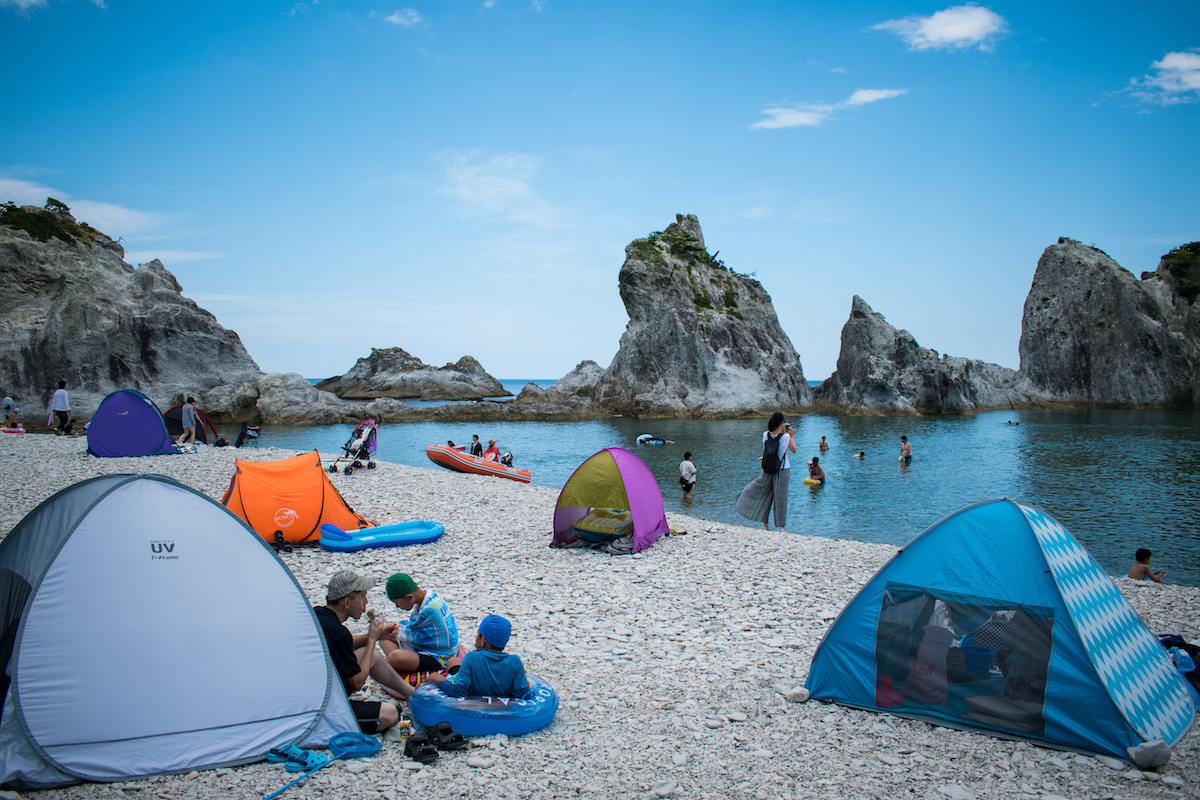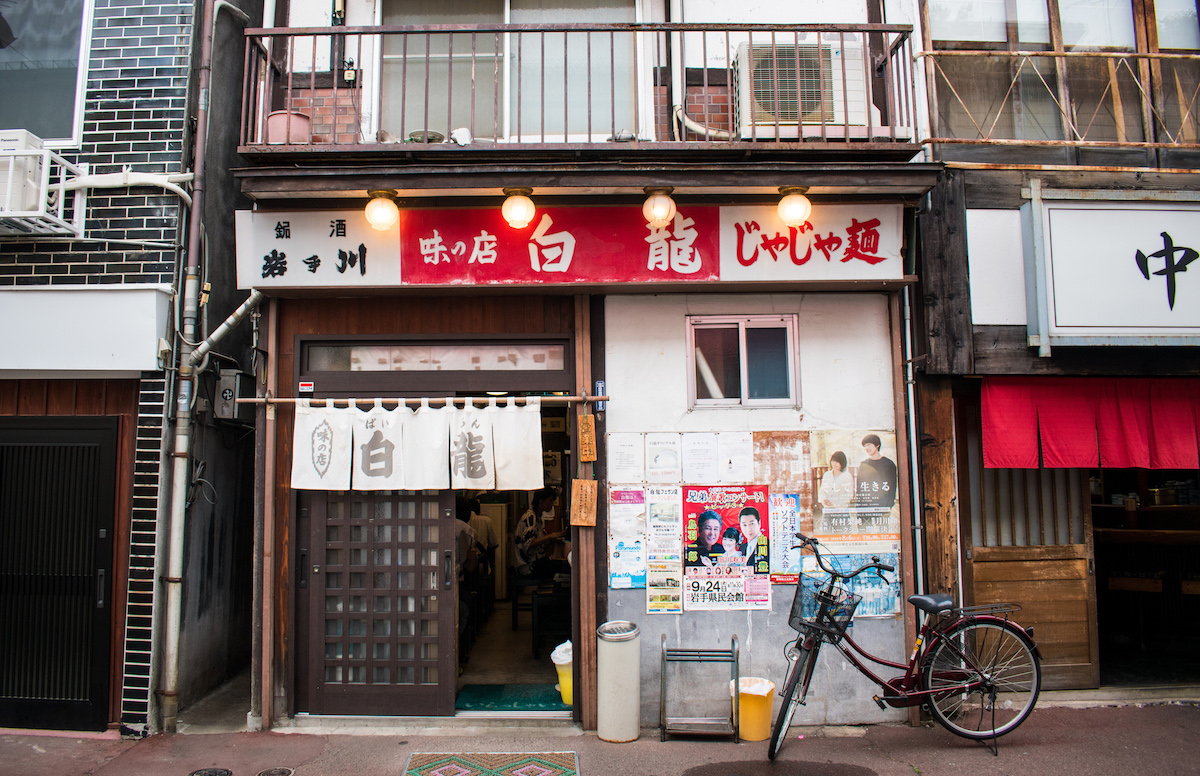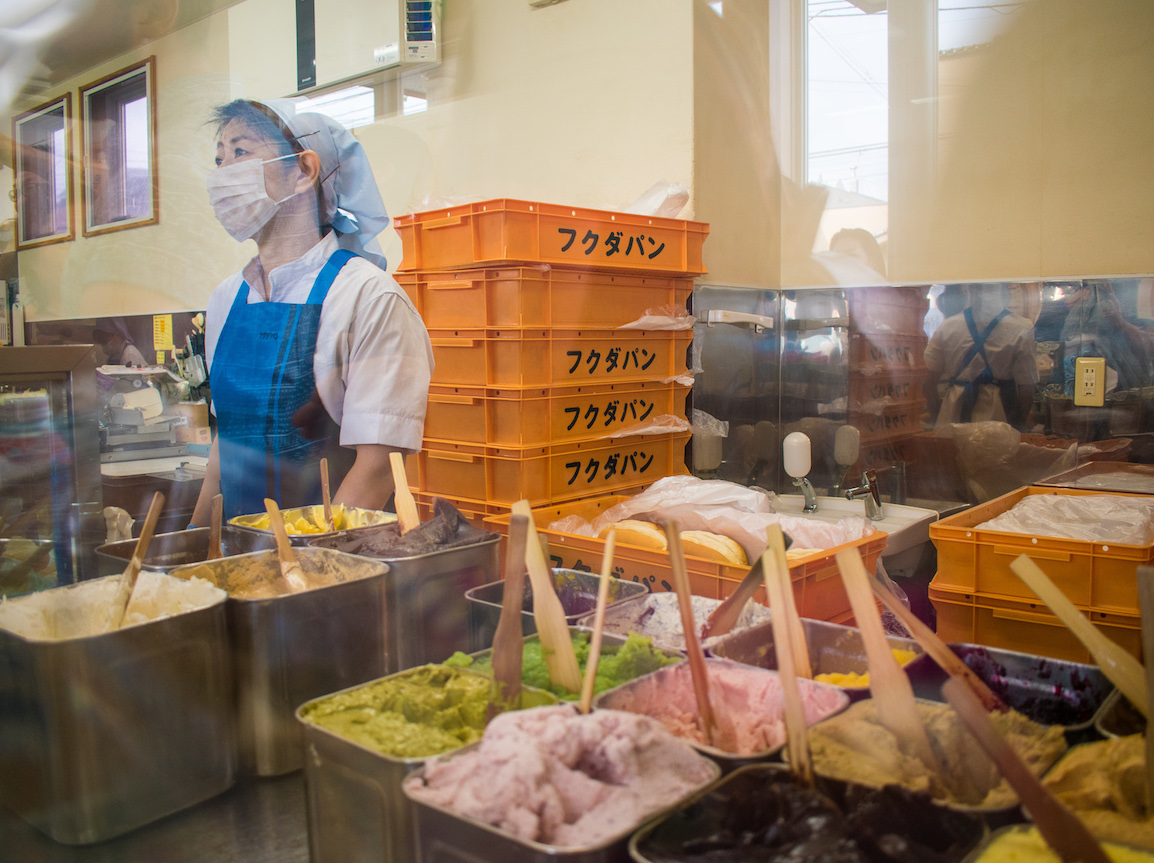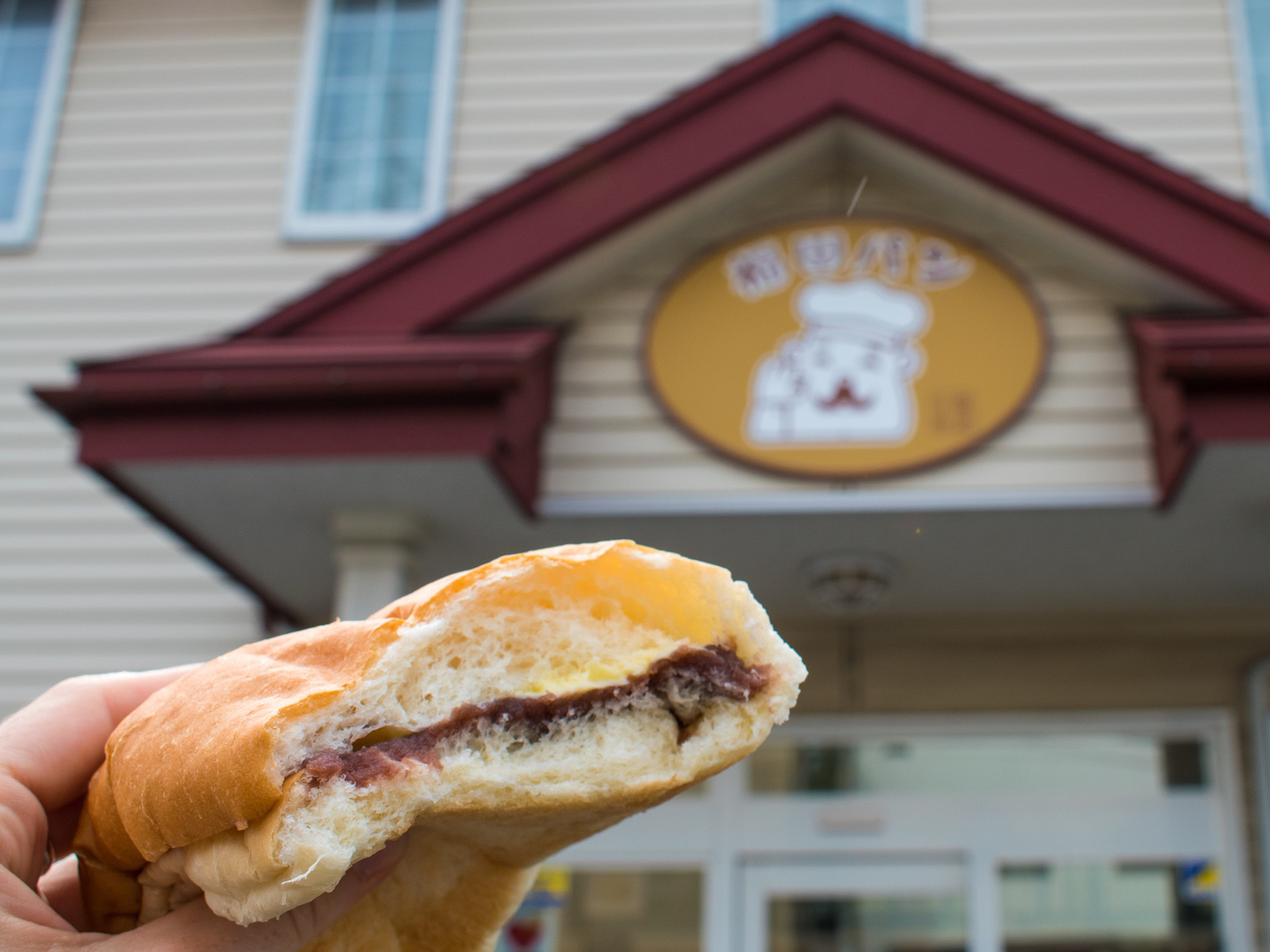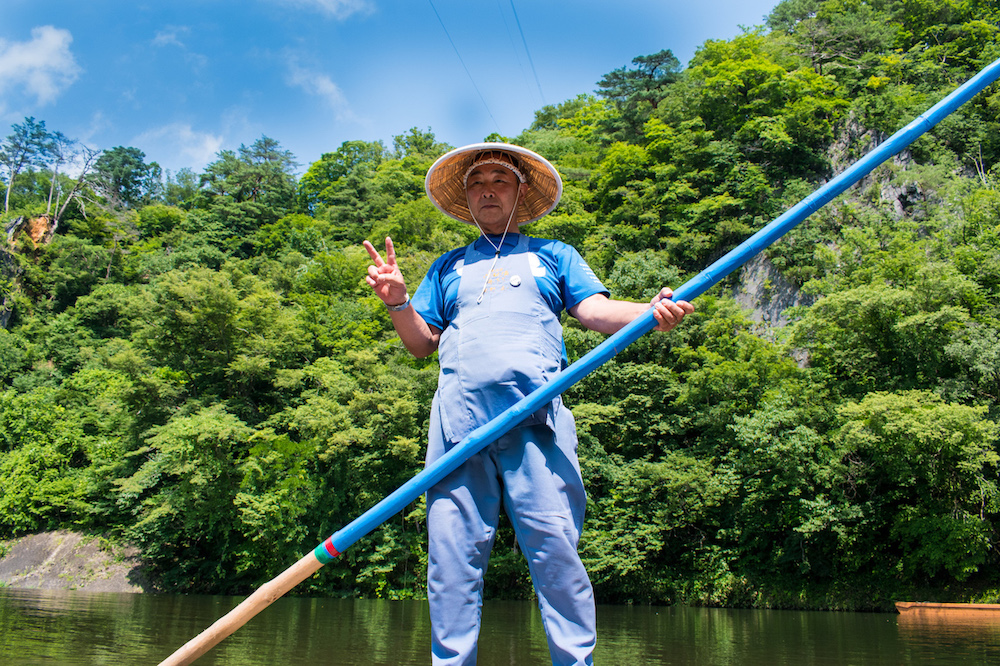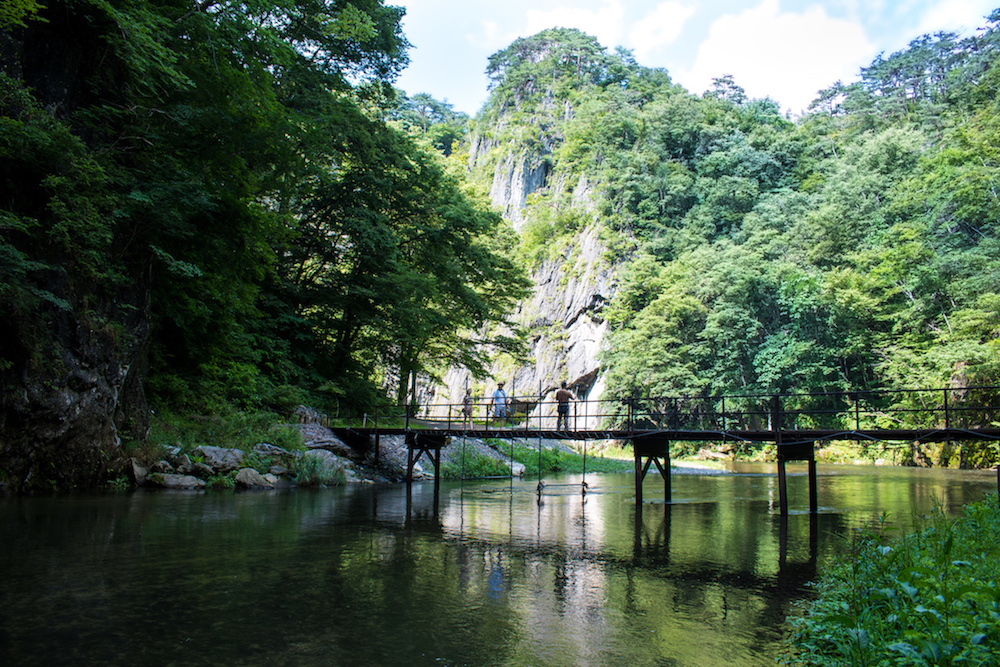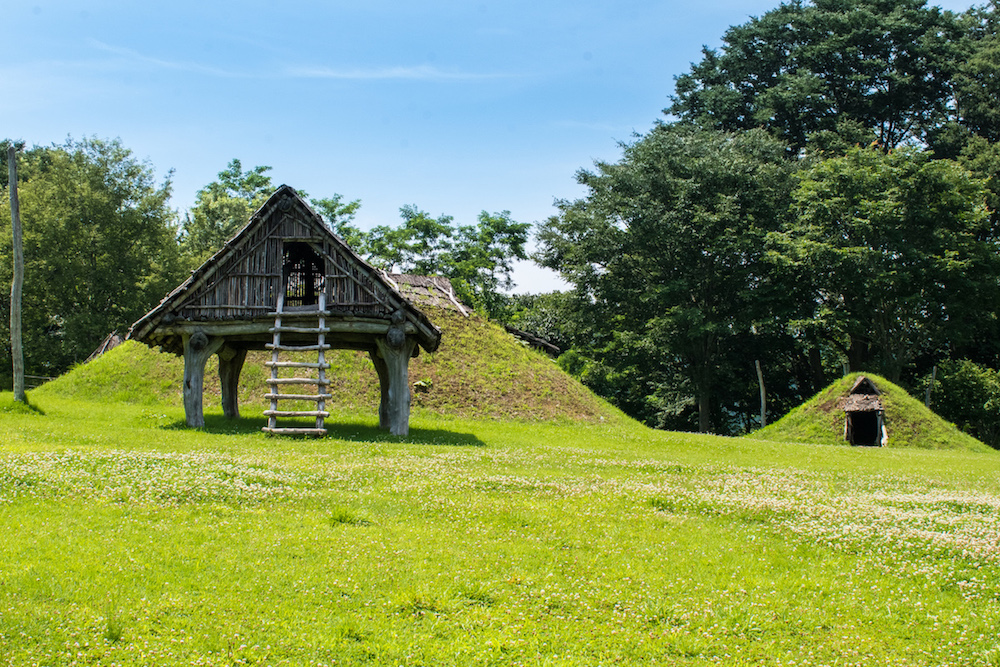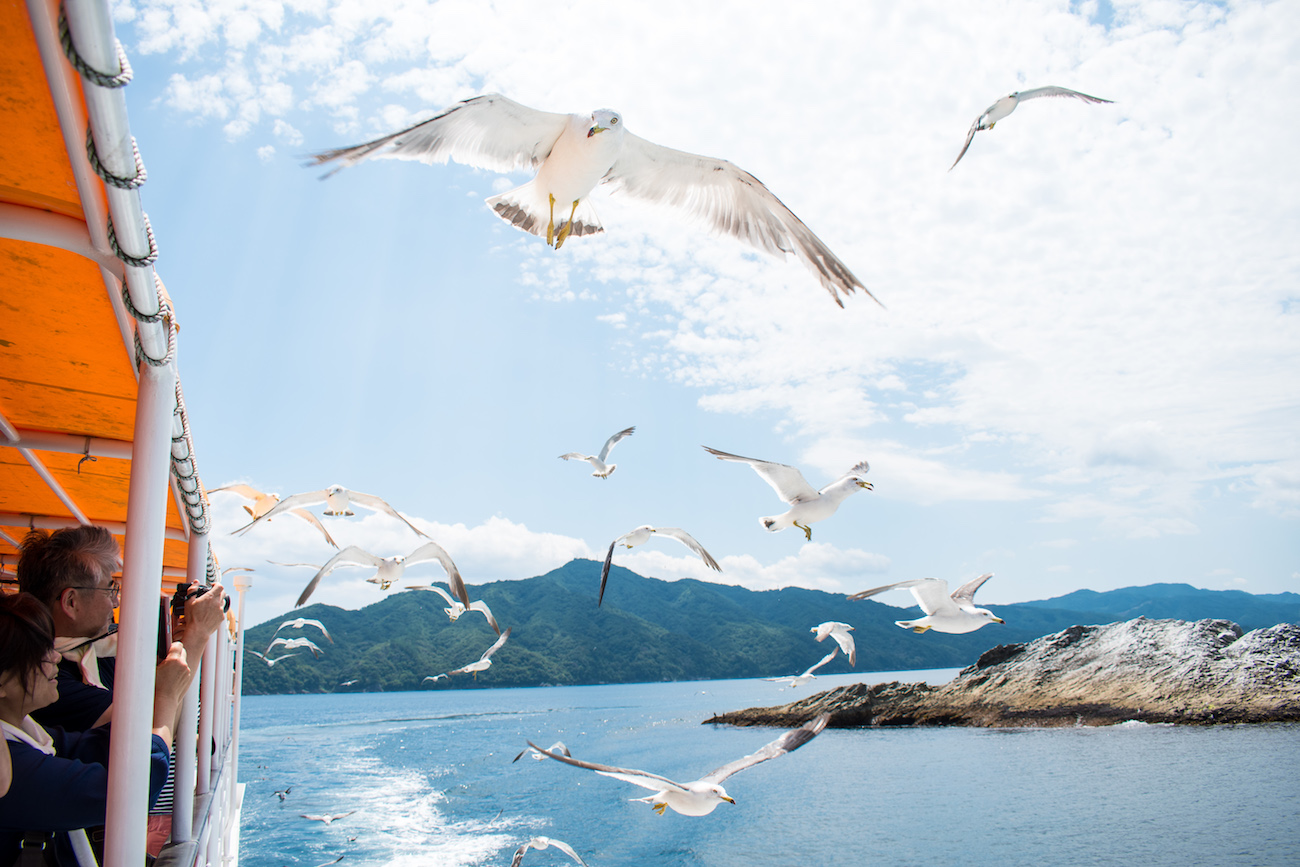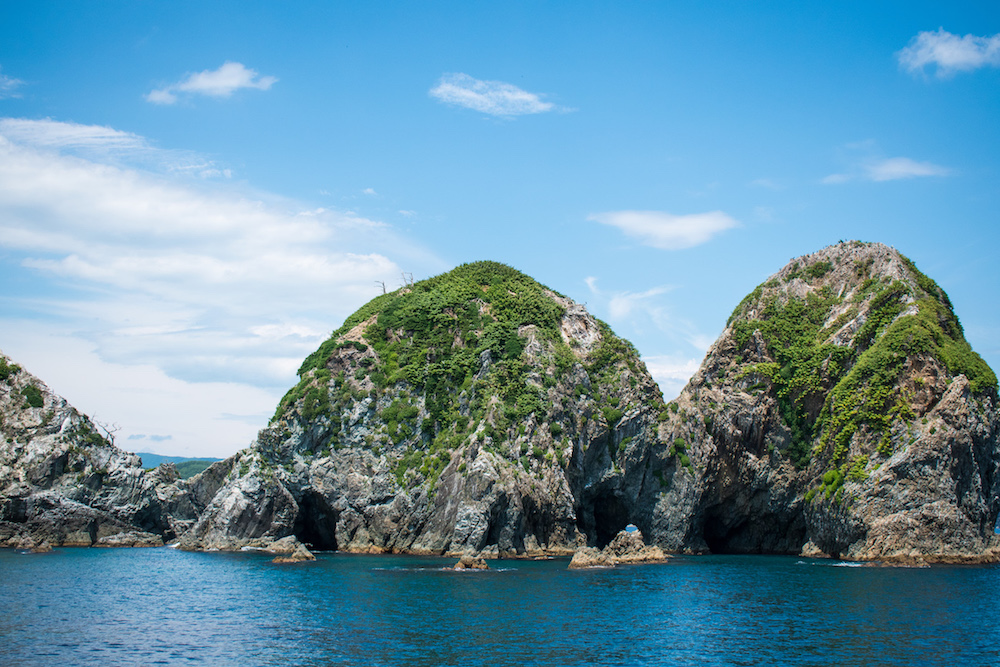東北北部に位置する岩手県は、秋田、宮城、青森の三県に囲まれ、その面積は北海道に次いで国内第2位。絶品の地元グルメや、日本有数の自然美に恵まれることでも知られている。
2011年、この地域は東日本大震災の被災地となった。数千人もの命が奪われ、各地で町が破壊されるなど、県全域で大きな被害を受けた。それから8年、岩手県は見事に復活を遂げている。いまだ再建中の地区もあるものの、岩手の自然の美しさは健在だ。森に覆われた山頂から、深く水晶のように澄んだ海で満たされた海岸線にいたるまで、岩手県は素晴らしく多様な魅力にあふれている。
自然の恵み豊かな岩手では、もちろん絶品グルメも自慢のひとつ。シンプルで美味しい盛岡市場の「ひっつみ汁」から盛岡定番の麺メニューまで、派手さはないけれど本物の味わいは折り紙付き、という岩手県そのもののようなグルメシーンが魅力だ。
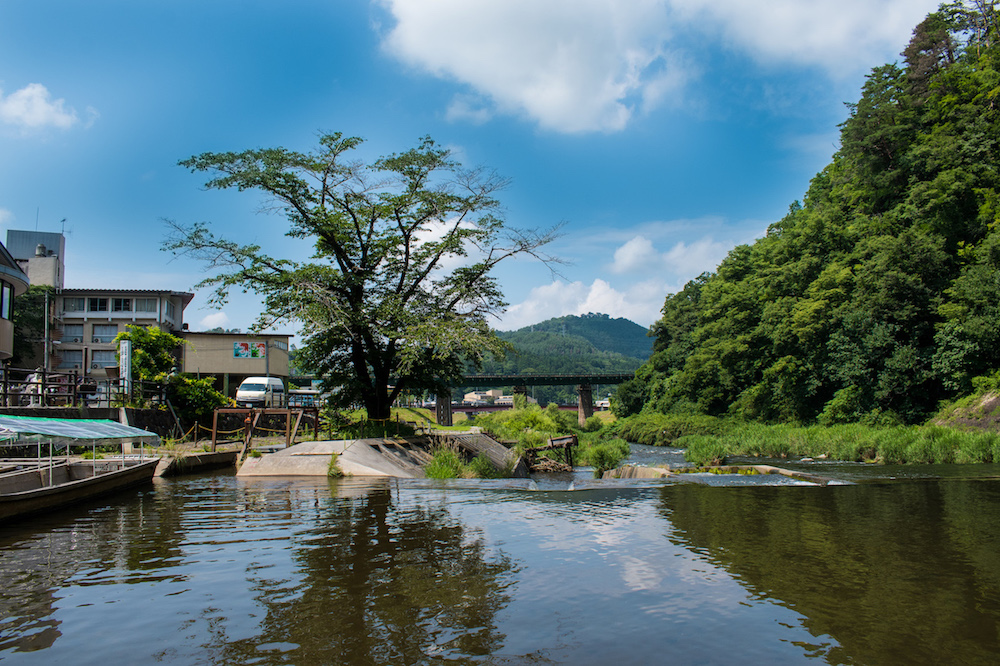
岩手グルメを満喫しよう
岩手には数多くの絶品名物料理があるが、その中でも有名なのが、ジャージャー面、盛岡冷麺、わんこそばの「盛岡の三大麺」だ。
まずは、アクション感あふれるわんこそば。お行儀よくいただく通常の料理と比べると、なかなか大変だ。わんこそばは、一口サイズのお椀に美味しいそばが入った料理だが、それを何杯食べられるか挑戦することこそが、醍醐味だ。各テーブルにはそれぞれ給仕がつき、お椀の中のそばがなくなるとすぐ、また次のそばを足してくれる。客が満腹になってお椀に蓋をするまで、それが延々と繰り返される。
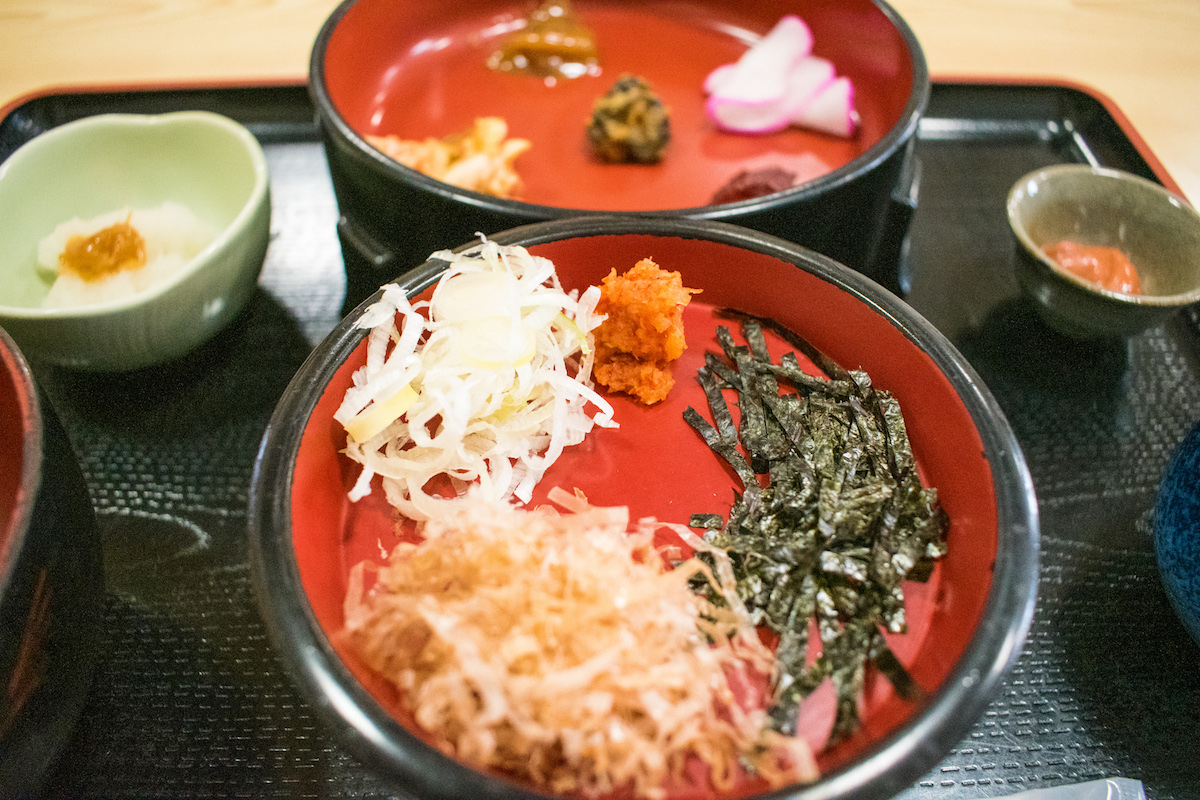
ただし、わんこそばだけで満腹になってはもったいので、ご注意を。次に紹介するのは、盛岡名物の1つ、ジャージャー麺だ。キュウリとひき肉、味噌、しょうがを混ぜた肉味噌をうどんのような太麺にかけていただくジャージャー麺は、中国の炸醤麺(ジャージアンミエン)をもとにアレンジされた郷土料理だ。ジャージャー麺発祥の店は盛岡市内にある、一見簡素な白龍(パイロン)という店だ。
ジャージャー麺の器が空になったら、シメにおすすめなのが「鶏蛋湯(チ―タンタン)」。これを食べなければ、本当の楽しみを味わったとはいえない。空になった器に生卵を割り入れ(たいていはカウンターに置いてある)、シェフに繊細な風味がする麺のゆで汁を足してもらえれば、完成。熱いスープを入れることで卵がかきたま状態となり、絶品スープができあがる。
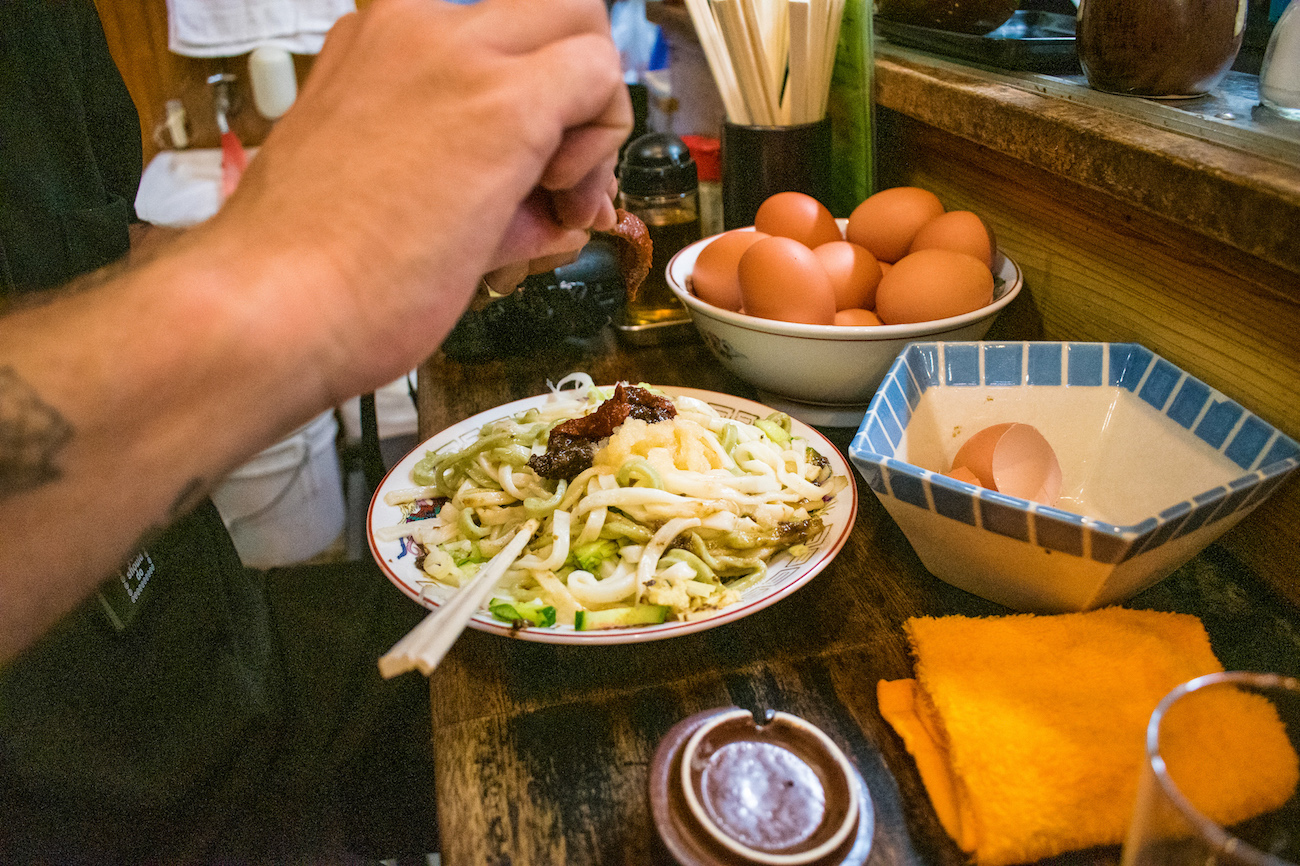
盛岡三大麺最後の1つが、盛岡冷麺。ジャージャー麺が中国なら、こちらは韓国からインスピレーションを得た料理。1954年、北朝鮮の咸興(ハムフン)市から日本に移り住んできた、青木輝人という朝鮮人男性が盛岡に初めて冷麺をもたらしたと言われている。それまでの冷麺と言えば、平壌スタイルのしこしこした冷たく辛い麺料理だったが、青木氏が独自に配合し、辛みを抑えたスパイスを入れるなど試行錯誤した結果、盛岡スタイルの冷麺が完成し人気に火がついた。通常はキムチ、漬物、スイカがトッピングされ、甘みと塩味、そして辛みが絶妙にマッチした逸品となっている。
1948年に「近くの大学の学生に、安くておいしいサンドイッチを食べてもらいたい」というささやかな願いから生まれた福田パンは、今や盛岡のB級グルメの王者だ。福田パンと言えば、軽くてふんわりとしたコッペパンを使用したサンドイッチ。具材は約60種類の中から2種を選ぶことができ、価格はほとんどのメニューが200円から300円程度。どのパンにしようか決められない、という方には長年にわたって絶大な人気の「あんこ」がおすすめだ。
自然美を楽しむ
猊鼻渓は岩手県で最も美しい景勝地の1つだ。高くそびえる渓谷は全長2 キロメートル、岸壁高さは50メートルに達する。猊鼻というのは「ライオンの鼻」を意味し、川沿いにある天然の石灰岩がライオンの鼻のシルエットのように見えることから、その名が付けられた。渓谷の全景を味わうなら、名物の舟下りがおすすめだ。底の浅いフラットボートを、船頭1人が竿一本で操縦する。所要時間は、往復約1時間半(途中休憩あり)。
折り返し前に立ち寄る休憩所は岩場の多い川岸にあり、川の向こうの崖の表面には複数の穴が開いている。そこに向かって「運玉」と呼ばれる石を投げ、見事穴に入れることができれば、幸運になれるという言い伝えがあるので、是非チャレンジしてみては。
緑豊かな御所野縄文公園の敷地は、縄文時代中期(紀元前1万4,500年から紀元前1,000年)に実在した大きな集落の跡地だ。是非、起伏のある丘に囲まれた広い平野を散策し、数千年前の人々の暮らしに思いを馳せてみてほしい。敷地内に点在する円錐形の小屋は、縄文時代の竪穴式住居。1989年から1993年に実施された発掘作業中に発見された。現在では歴史的重要性が認められ、ユネスコ世界文化遺産への推薦候補に選定されている。外の景色を楽しんだ後は、プロジェクトマッピングやスタイリッシュでモダンなギフトショップが魅力の博物館に立ち寄るのもお忘れなく。
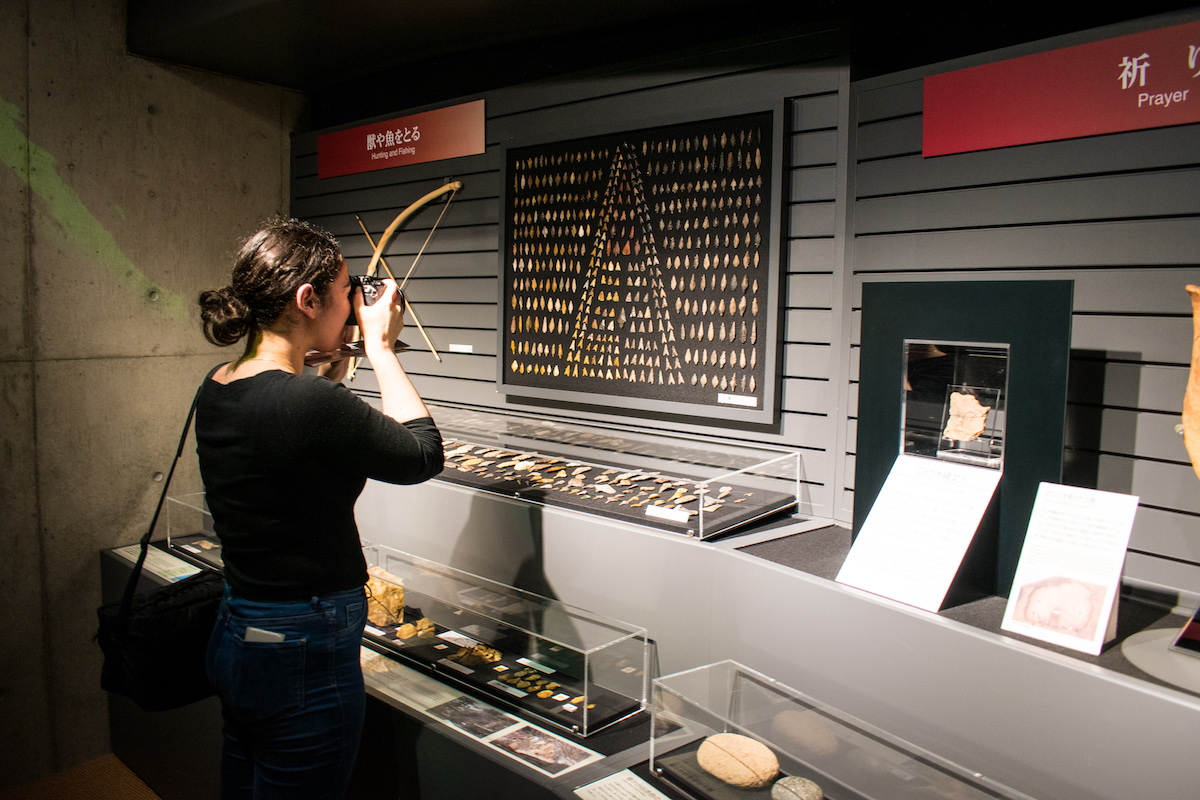
浄土ヶ浜は岩手県を代表する景勝地。白と灰色の小石が敷かれたような海岸と澄んだアクアブルーの海水は、その昔、霊鏡竜湖という名の僧が「さながら極楽浄土のごとし」と称賛したと伝えられている。三陸海岸の一角にある美しい砂浜の最大の名所は、波穏やかな海から巨大な岩が鋭く突き出す、奇岩の峰だ。この場所は東日本大震災で津波の被害に遭ったが、その素晴らしさは今も変わらない。浜にはビジターセンターが置かれ、クルージングツアーの発着地でもある。別の角度からも海岸を楽しみたい、という方はみやこ浄土ヶ浜ボートクルーズに参加しては。三陸海岸沿いを40分かけてクルージングする船からは、ユニークな岩々が織りなす、素晴らしい景色を眺めることができる。
- All Photos by Lucy Dayman
東京からの行き方と滞在場所
岩手県を広く探索するなら、県庁所在地のある盛岡を拠点にすると便利だ。市内中央にある盛岡駅には、東京からJR東北新幹線で約2時間半。
街を散策するなら、盛岡都心循環バス「でんでんむし」を利用するのがおすすめ。バスは10分ごとに運行しており、城跡公園を経由して盛岡市街を周遊する。ワンデーパスが300円で販売している。
—
All photos by Lucy Dayman
—
Lucy Dayman | ルーシー・デイマン
オーストラリア生まれ。2016年、オーストラリア・メルボルンでのカルチャー・音楽雑誌の編集の仕事を辞め、日本で旅をしながら仕事を始める。フリーランスライターとしての仕事と旅の傍ら、フィルム写真を撮影している。
Instagram: @lucy.dayman.
HP: lucydayman.com
Nestled between Akita, Miyagi, and Aomori, in the northern region of Tohoku, Iwate is Japan’s second-biggest prefecture after Hokkaido. It’s also one of the most naturally stunning prefectures on the map, with an incredible culinary scene to boot.
The area was devastated by the Great East Japan Earthquake of 2011, which claimed thousands of lives and demolished townships across the prefecture. In the eight years following the disaster, Iwate has bounced back. While parts of the area are still in reconstruction, Iwate’s natural beauty is completely undeniable. From the forest-covered mountain tops to the deep crystal clear waters that fill the coastline, Iwate is a prefecture of incredible diversity.
When you have a site with such bountiful natural gifts, it’s no surprise that Iwate is also is home to incredible food. From the simple and delicious hittsumi-jiru stew of the Morioka Market to the Morioka’s legendary noodles, the culinary scene is an embodiment of the prefecture itself; understated but self-assured and authentic.
Eating your way through Iwate
Iwate is a prefecture practically overflowing with incredible cuisine, but its biggest claim to fame is its ‘three great noodles of Morioka.’ These three noodles are jajamen, Morioka reimen, and wanko soba.
Let’s begin with the most action-packed of the bunch, wanko soba. It’s more eating challenge than a civilized meal. Wanko soba is classic delicious soba served in individual mouthful sized bowls. The aim of the game is to see how many bowls of the noodles you can knock back in one sitting. Diners are assigned a server whose sole duty is to stand there and continue passing you bowls of noodles until you can take it no more and cover your bowl as a sign of defeat.
Don’t eat too many bowls of wanko soba, because you’ll want to save room for jajamen, one of Morioka’s other famous dishes. A bowl of thick, udon-like noodles topped with cucumber and a scoop of nikumiso, a combination of meat, miso paste, and ginger, it’s a local creation inspired by a Chinese dish known as zhajiangmian. In the city of Morioka is a humble-looking store called Pairon, this establishment is reputed to be the original home of the meal.
Once you’ve eaten all your jajamen noodles, only half the dish is done. Next step is the ‘chitantan.’ to make chitantan, crack a raw egg – which is usually available on the counter – into your bowl and ask the chef to fill the bowl with delicately flavored broth. This piping hot broth cooks the egg making a comforting, filling soup.
Morioka reimen is the third of these great noodles. Similar to jajamen, this dish was inspired by its international neighbors. A native of Hamhung North Korea, named Teruto Aoki brought the chilled noodle dish to Morioka in 1954 after moving to Japan. Korea’s chewy Pyongyang cold noodles were rather common in Japan before this, but it was Aoki’s careful combination of spice to the typically non-spicy dish that made it famous. A surprising combination of sweet, salty, and spicy, Morioka reimen often comes topped with kimchi, pickles, and watermelon.
Founded in 1948 with the humble ambition to serve cheap, tasty sandwiches to students from the nearby college, Fukuda Pan is Morioka’s unassuming culinary hero. Fukuda Pan’s sandwiches are served on a bread called “koppe pan.” It’s light, fluffy and similar to an American hot dog bun. Here you can choose two of around 60 different types of sandwich toppings. Most sandwiches will set you back between 200-300 yen. If you don’t know what to choose, go for the ‘anko’ (red bean paste) which has long been one of the store’s most popular choices.
Seeing the natural sights
Geibi Gorge is one of the most beautiful sites in all of Iwate. This towering gorge runs two kilometers long and has cliff faces that reach an imposing 50 meters high. Geibi got its name from the Japanese word for ‘lion’s nose,’ because along the river sits a naturally crafted limestone rock which looks like the silhouette of the snout of a lion. To see the gorge in all its glory, take a cruise along the water on the iconic flat-bottomed boats. The boats are powered by a single boatman and a pole. The journey takes about an hour and a half with a stop off at the halfway point.
At the stop off halfway along the cruise sits a rocky shore. Across the river from the shore etched into the cliff face is a hole, pick up some stones “undama” or “luck stones” from the nearby stand and try throwing one into the hole. The legend has it that if you get the stone into the hole, good luck is in store for you.
The lush open grounds of Goshono Park were once home to a large settlement that existed sometime during the mid-Jomon period (14,500 B.C.~1,000 BC). Today you can wander the flat open land, admire the backdrop of the rolling hills that surround them, and imagine what life was like all those thousands and thousands of years ago. Scattered across the map, you’ll find cozy cone style huts; these are ancient pit dwellings. These dwellings were discovered during excavation between 1989, and in 1993, while today it’s now considered a site national historic significance. After exploring the site outside, be sure to explore the state of the art museum complete with projection mapping displays and a stylish and modern gift store.
Jodogahama Beach is a landmark of the prefecture. Its white and grey pebble shore and clear aqua-blue water were compared to paradise by a Buddhist monk named Reikyo. A picturesque corner of the Sanriku Coast, this beach’s most distinguished natural features are the jagged giant rock peaks that protrude through the gentle waves. The site was hit during the 2011 tsunami but is now as stunning as ever. It’s home to a visitor center and several cruise tours. If you want to see the shore from a different angle, take the Miyako Jodogahama Boat Cruise. This 40-minute journey travels along the Sanriku Coast, offering incredible views of the unique rock formations.
How to get there and where to stay
The best place to set up a home base when exploring wider Iwate would be the prefecture’s capital city, Morioka. It takes about two and a half hours from Tokyo via the JR Tohoku Shinkansen, and the train arrives at the city’s central station, Morioka Station.
If you want to explore the city, the easiest way to get around is via the Dendenmushi Loop Bus. The bus operates every 10 minutes and travels around downtown Morioka via the castle ruins park. This bus costs 300 yen for a 1-day pass.
